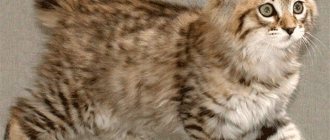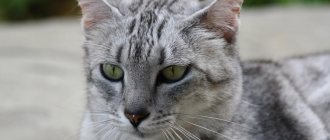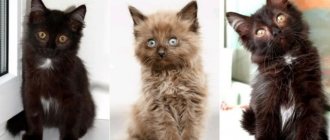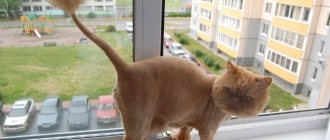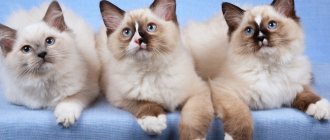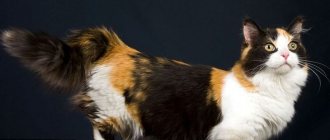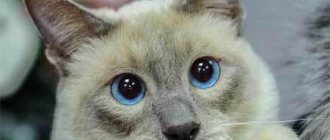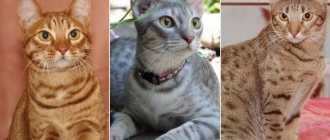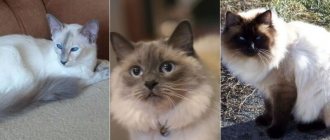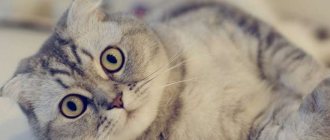Many people, when choosing a pet, are guided not only by the external characteristics of the breed, but also by the character. It is believed that representatives of ancient breeds are the friendliest, most flexible and trainable.
The Egyptian Mau has been known since the ancient kingdom. This is a graceful, intelligent animal with a unique color, bright contrasting stripes and spots on incredibly soft fur.
Health and content
Since Mau has a tendency to obesity, it is necessary to arrange regular active physical activity to keep her in shape.
Daily walks in the fresh air and outdoor games will be useful. This cat needs space; living in an apartment with a small area can depress the pet. It is important to make sure that he has personal space, toys and a scratching post. Try to purchase a multifunctional, multi-level cat house, so the Mau can climb to his heart’s content during the day and stretch his muscles
There is nothing difficult about walking this breed: cats are used to living at home, but if the weather is warm outside, they will not refuse a walk. Don't forget to put a flea and tick collar on your pet to protect the kitten. It is better to walk Mau on a leash; cats are completely calm about this and do not resist. This way you will ensure your pet’s safety during a walk. It is worth remembering that the Egyptian has no undercoat and is sensitive to temperature changes. Walking in winter can only be done in warm clothes.
The Egyptian Mau is one of the elite breeds, so it is important to take care of an appropriate healthy diet. When choosing food, opt for premium and super-premium food
If you are a supporter of natural nutrition, keep in mind that waste from the master’s table is not suitable for feeding an Egyptian woman. She needs daily meat intake (chicken, beef). Do not include a lot of porridge in your diet, as porridge is difficult for digestion.
Include in your daily menu: meat, sea fish, dairy products, vegetables, fish oil. A bowl of clean water should be available at all times. Kittens and pregnant cats need to be fed 4 times a day, adolescents - 3, adult cats 2 times. The appearance and health of a cat directly depends on a balanced, proper diet. You should not overfeed your pet; overeating leads to obesity, which causes health problems and shortened life expectancy.
The longer breeders breed Egyptian Mau, the healthier the kittens are born in nurseries. But still there are diseases to which the breed is susceptible:
- Allergy
- Asthma
- Hypertrophic cardiomyopathy
Any breed of cat, regardless of predisposition to certain diseases, needs timely, high-quality vaccination against herpes virus infection, calcivirosis, and panleukopenia. From 6 to 8 weeks the first vaccine is given, a month later a revaccination is required. The second vaccination is done from 6 to 8 months. Next, vaccinate your pet every year.
Plan to breed your Egyptian Mau no earlier than the third heat. This process should not be delayed; the cat should not be older than one and a half years old. The older he gets, the more difficult it will be for the cat to approach. Mating can be organized only after the animal has been examined by a veterinarian and the prescribed vaccinations have been completed. Before you decide to breed such a rare, exotic breed, you need the Mau to take part in an exhibition at a local club and earn a breeding assessment.
By purchasing an Egyptian kitten, a person gains not only an elite pet, but also an intelligent companion, a playful, devoted comrade, and a dexterous hunter.
It is important to take into account that this animal needs constant attention, love, and quickly becomes attached to its owners.
Wild African (steppe) cat
The African wild cat, also known as the steppe cat, lives throughout almost all of Africa. Today this cat can be found in almost every corner of the world. This cat is somewhat larger than its domestic relatives and has a specific coloring that determines the halo of its habitat. The color is predominantly sandy, gray-yellow or reddish-brown with black spots on the back and sides. The long tail of the African predator is decorated with several black rings.
The body length of an adult is 63-70 cm. The tail length is around 23-33 cm. The height of the cat at the shoulders is approximately 35 cm. The average weight of cats is between 3-8 kg. Some individuals reach 11 kg. At the same time, steppe cats are half the size of domesticated cats. The average life expectancy is 12-15 years. Cats reach puberty at 11 months of age. Duration of pregnancy: 56-63 days. Brood: from 1 to 5 kittens per litter.
It was this breed of cat that the ancient Egyptians domesticated 6,000 years ago to fight rodents that raided granaries.
Care and maintenance
The Egyptian Mau is a rather finicky cat breed to care for. It requires careful handling and the most attentive attitude towards oneself from a very early age. You can brush them once every two weeks, or once a week during shedding. Some individuals love to swim; water procedures can be carried out two or three times a year, more often it is possible, but not necessary. Ears and eyes are cleaned as needed. But all these are ordinary standard care procedures, the main problem that can await the owners of Egyptian beauties is not the best health and low immunity. Therefore, when buying a kitten, you should carefully study the pedigree and veterinary passport of the parents.
Egyptian Mau are quite vulnerable to several diseases. There are a number of characteristic diseases for this breed: asthma and cardiomyopathy.
To date, geneticists have almost managed to get rid of these shortcomings, but it is still worth paying attention to. It is also worth remembering that the Egyptian Mau's respiratory system is sensitive to dust, tobacco smoke and other air pollutants
This breed has another scourge - allergies. This can cause a lot of trouble. Therefore, it is worth paying special attention to nutrition issues.
Their physical development and hunting skills are fine. But due to their poor health, it is highly undesirable to let them go outside. For all their qualities, Egyptian Mau are exclusively domestic cats. With proper care, timely vaccinations and good nutrition, they can live approximately 12-14 years. This is a normal life expectancy for cats.
Results
Reviews about the Egyptian Mau are always positive. These beautiful creatures are gifted with a high level of intelligence, and therefore have special devotion and affection for the person they like. Cats of this breed are carriers of royal manners, and therefore they react extremely negatively to rude and disrespectful attitude towards themselves.
It is worth noting that Mau are one of the best candidates for the role of a furry life friend among domestic cats, who will eagerly wait for you at home and gratefully respond to kindness, love and care. According to reviews from owners, the breed is very peaceful, friendly, and loyal. A funny face only adds charm to the Mau.
Care and maintenance
Short-haired Egyptian Mau are not picky about their upkeep, but rest assured: you won’t have any remorse in leaving such a charming beauty untidy. These cats do a pretty good job of grooming their own coats, but brushing the fur with an Egyptian Mau brush or mitten won't hurt. This massage will not only give your pet a neat look, but will also strengthen the hair follicles.
The breed is famous for its cleanliness, so many Mau owners do without water treatments at all (with the exception of playing with mini-waves in the bath). However, before participating in the exhibition, it is recommended to bathe your pet with cat shampoo. For silver-colored Mau, you can choose a tonic that will make the color more saturated and rid the coat of yellowness. After taking a bath - and it can last for more than an hour due to the inexhaustible love of cats for water - eliminate the source of possible drafts so that the pet does not catch a cold.
Eye care for the Egyptian Mau is minimal. Due to their specific structure, they rarely tear, and there is practically no discharge in the corners. The animal’s ears will have to be given more attention: in particular, they should be inspected once a week and cleaned with a damp cotton pad as necessary.
Egyptian Mau drinks tap water
Oral hygiene is no less important. Once or twice a month, clean your cat's teeth from plaque using a paste (you can find it at a pet store). Use a brush or attachment; in extreme cases, a finger tightly wrapped in a bandage will do. From time to time you can please your pet with special treats, which, due to their hardness, carry out preventive teeth cleaning.
To create a neat “manicure” on the paws of the Egyptian Mau, use a nail clipper. After the procedure, it is necessary to smooth out sharp edges and jagged edges using a nail file. To do this as little as possible, teach your cat to use a scratching post. Otherwise it will become a piece of furniture.
Looking at the Egyptian Mau, it is difficult to imagine that this graceful body hides a small gourmet and glutton. Representatives of the breed love to eat delicious food, so they do not control the size of portions. This responsible mission lies with the owner, who must ensure that the pet moves actively, eats in moderation and remains just as graceful.
It is preferable to feed the animal with premium food - dry or canned.
Ideally, you should pay attention to options designed specifically for the breed. Egyptian Mau often suffer from food allergies, so finding the right food can take months.
If you are ready to often pamper your cat with home-cooked dishes, stock up on dietary meat, sea fish, offal, seasonal vegetables and fruits, as well as sources of calcium.
Remember: it is strictly forbidden to combine two feeding options - this is fraught with problems with the gastrointestinal tract.
The Egyptian Mau should not eat:
- fatty meat (pork or lamb);
- spices (even in small quantities);
- river fish in any form;
- vegetables with a spicy taste;
- dry dog food;
- legumes;
- tubular bones;
- milk;
- liver;
- mushrooms;
- nuts.
Since these cats are very active, it is necessary to provide them with access to clean and fresh water. Mau owners recommend using bottled water, noting the fastidiousness of the “Egyptian”. Animals have inherited from their wild ancestors an instinct with which they determine whether water is suitable for consumption.
To do this, the cat puts its paw into the bowl and carefully tastes the liquid.
Standard regarding wool
Special requirements of the cfa classification standard apply to the coat of the breed. The fur coat should be short and slightly raised. Color options:
- Smoky with a dark “picture”;
- Bronze case with chestnut pattern;
- Silver with ash pattern is the most popular color;
- Light bronze with copper markings.
The coats of the Egyptian Mau should have several ticking rings - different colors on one coat. Also, on the cat’s chest there is always one or two “necklaces” - non-locking rings. There are “bracelets” on the paws. The breed standard specifies that the bracelets must be identical in a pair - the bracelets on the front legs match each other, as well as on the back pair.
The standard is also picky about the tail. It should have dark colored rings.
The standard provides for the presence of “special features”. A true representative of the breed must have the characteristic letter “M” above the eyes, and above, on the head, a mark in the form of the letter “W” (scarab). The eyes must be emphasized by “thoroughbred” makeup - two lines towards the cheekbones.
Until the age of 18 months, eye colors in shades of yellow are allowed, however, by adulthood, the cat’s iris takes on the color of a young gooseberry. A mandatory feature of a purebred Mau is eye mobility. The cat should be able to rotate them without changing the position of the head.
How to choose a kitten
Finding a real purebred Mau is not so easy. To avoid being the owner of an unknown animal, you should resort to the services of specialized nurseries. Preliminarily familiarize yourself with their reputation and customer reviews. Carefully study the pedigrees of the kittens offered.
A kitten can move to a new family at three months of age. By this point, he becomes quite independent from his mother, the cat.
When choosing a baby, you should pay attention to his well-being. He should be playful and very active. Outwardly look moderately well-fed and well-groomed. With a clean nose, eyes and ears.
A distinctive feature of real small Mau is the appearance of fuzzing at two months of age. That is, the presence of light sparse long hairs. What makes little kittens look like porcupines. This is a kind of camouflage inherent in all wild cats. Passes by twenty weeks.
In addition, already in early childhood, the Mau develops a characteristic pattern above its eyes in the form of the letter “M”.
See also: The kindest cat breeds that exist in the world
When buying a spotted friend, you need to understand whether he will participate in exhibitions. If potential owners plan to raise a future champion, then they should choose silver, bronze or smoky color.
Black babies are not allowed to exhibit, but they also cost much less.
The price of a show class kitten will be over one hundred thousand rubles. Thoroughbred Mau, intended exclusively for the joy of the owners, will cost an average of fifty thousand rubles.
Features of feeding and diet
An active, playful cat requires high-quality nutrition that will allow it to replenish lost energy. The daily diet should contain at least 90 kcal per kilogram of animal weight.
Due to the Egyptian Mau's proneness to allergies, only specially formulated premium foods can be fed. If dry food is not your choice, you can stick to natural food. What is recommended for Egyptian women to eat:
- rabbit meat, chicken;
- sea fish without bones;
- offal;
- low-fat cottage cheese, sour cream;
- cereal porridges;
- boiled vegetables.
It is worth taking care of the availability of fresh, clean water. You can use purified bottled water. Cats have inherited from their ancestor, the African wild cat, the instinct to determine whether water is suitable for drinking or not. To do this, the animal wets its paw in a bowl and tastes the liquid.
Appearance
The official breed standard states that a purebred Egyptian Mau should be of medium size with a graceful build.
Despite this, the muscles of these animals are well developed. Legs of medium length with oval paws.
The tail tapers slightly at the end. The weight of the animal should be from 3 kg (for cats) to 6 kg for males.
Pros and cons of the breed
The elite breed is not only characterized by unique character traits, but also has some requirements that not all owners can meet. Conscientious breeders always warn about the hidden shortcomings of the breed so that the owner understands that he is taking a pet not only for his own pleasure. Before choosing a pet, evaluate your capabilities, routine and habits in accordance with the list of indicated advantages and disadvantages.
The advantages include the following features.
- Good health, low morbidity rate. Mau is an indigenous breed, therefore, they are characterized by strong immunity. A vaccination system will help protect your cat from infections.
- High intelligence and a good degree of learning require constant development so as not to get bored.
- Devotion, affection, high socialization. Doesn't like to be alone for a long time. This can lead to depression or start acting out.
- Love of bathing. I am ready to take water procedures often. Sometimes it can play with a stream of water from a tap or put its paws in a bathtub filled for its owner.
- High activity regardless of age. Constant games are required so that the pet does not get bored.
At the same time, the disadvantages include those criteria that follow from the indicated advantages.
- Independence. You can’t force yourself on a cat, she doesn’t like it. Therefore, if you want constant lisps and cuddles, then the breed is not for you. For the same reason, Mau are not suitable for small children.
- Volume. Cats of this breed purr very loudly during estrus, express all emotions with a characteristic meow, and are able to “talk” with the owner, expressing their emotions. Not all owners can tolerate the constant sounds made by the Mau. It should be noted that most cats are still silent; it is easier for them to express feelings by moving their tail or stomping.
- Get ready for the fact that your pet absolutely cannot stand boredom and loneliness. If you are away from home for a long time, then know that you will make the cat suffer. She will express her experience in some kind of entertainment, for example, she will start playing with wires, taking things out of closets, jumping on shelves and other “fun” activities.
- Problems during the period of “sexual” hunting. If the male cat is not sterilized, then in the spring you will experience uncontrollable behavior. They will scream loudly, scratch, and damage interior items. Experts advise that it is necessary to carry out the sterilization procedure if breeding is not planned. The operation is performed at the age of 6 months, which will make the pet calmer.
- Binge eating. Unfortunately, this trait is characteristic of the breed; you will have to constantly monitor the cat.
- Rarity. The closed nature of the breed indicates its exclusivity, which accordingly increases its cost and increases the risk of encountering scammers.
Description of the Egyptian Mau breed
What does an Egyptian Mau look like and what are the differences, say, from the currently fashionable Bengal cats? Indeed, at first glance, these breeds have a lot in common, but already the second and third ones convince us that Egyptians have their own characteristics. Do Bengals have the exclusive scarab beetle color? Did evolution inscribe the mysterious “M” on the foreheads of other pussies? After all, who but Egyptian women can pronounce “Mau” clearly? So the breed standard convinces that the Egyptian Mau cat is unique and inimitable.
- The head of the Egyptian Mau is wedge-shaped, very harmonious - neither excessive roundness nor unnecessary pointedness is observed. There is a noticeable hump in the nose area:
Egyptian women's ears are either medium or large. They are set high, sharp at the tips, tassels are allowed, the ears are set on alert, the ears are covered with short hair;
The goddess Bastet (a woman with the head of a cat) once worked on the appearance of the Egyptian Mau; since then, their large almond-shaped eyes have been decorated with “goddess makeup” - distinct eyeliner lines.
The description of eye color in the breed standard is limited to the shade “young gooseberry”. Although young animals cannot always please their owners with unripe berries. From 8 to 18 months, some kittens change eye color, but after one and a half years, Mau eyes should only be green!
IMPORTANT! Experts who evaluate an animal's compliance with breed standards suggest how to determine that this is definitely a Mau - pay attention to the cat's gaze. If he is a little amazed, this is the Egyptian Mau in all its amazing glory!
- The body of the Egyptian Mau cat is compact, graceful and strong. The Mau has a loose fold of skin on its belly, thanks to which Egyptian beauties can take a wider step compared to other feline beauties.
- The limbs are medium. The hind limbs are longer than the front ones, but due to the special gait, the back always looks straight. The paws are slightly oval in shape, and the toes on the hind legs are longer than on the front ones.
- The tail is also medium, its thickness is almost the same along the entire length of the tail, only towards the very tip it narrows and the tail becomes pointed.
- Speaking in general about the body and muscles of the Egyptian Mau, it can be noted that they are very slender. According to the standard, neither excess weight nor thinness is welcomed. The right balance is the key to Egyptian beauty.
- An Egyptian cat weighs 3-4 kg, but a handsome male weighs 4-6 kg. Moreover, reviews from owners are unanimous that cats are more graceful and muscular than females.
- The short hair of Egyptian Mau cats is surprisingly soft and silky to the touch. It shines well in the sun and has its own characteristics - each hair has 2-3 ticking rings. Non-closing ring-necklaces decorate the breasts of Egyptian women; transverse non-closing stripes are located on the front legs from the shoulder and the hind legs from the hip.
- Egyptian Mau are also unique in that out of almost 256 known cat breeds in the world, they are the only ones with a spotted color of natural origin. Moreover, the spots form hairs that are colored only at the very tip. The spots on the cat’s body are scattered chaotically, as noted above, but on the animal’s forehead they form a distinct letter “M”. In addition to the “M”, a visually noticeable “W” is inscribed in spots in the area of the ears towards the back of the head.
In general, spots are a breed-forming characteristic for the Egyptian Mau. They should be clear, ideally round and contrasting. No description can convey the beauty of this spotted coloration! “Mackerel” (merging of spots into stripes) is a disadvantage of the breed.
Three colors are approved by the standard for Egyptian Mau:
- silver color. Silver-toned coat with charcoal markings;
- bronze color. The coat is light bronze and the markings are chocolate;
- smoky color. The coat is gray, with a silver undertone, and black markings.
Sometimes black Egyptian Mau or "merle" ones are born in a litter. This is the so-called “wild color”, when white wool is combined as the main tone and red as the markings. Males and cats of such colors do not participate in exhibitions or breeding.
Another important point. Often 2-5 month old kittens are covered with phasing, which gives them a neglected and unattractive appearance. Do not worry. By six months, your “ugly duckling” will turn into a classic Egyptian!
Read what a kitten needs in a new home.
Breed exterior
The Egyptian Mau is distinguished from other breeds by many appearance features characteristic only of this species. Thus, the first things mentioned in the description are the long graceful body and paws, the characteristic pattern on the top of the head called a “scarab,” as well as bright “arrows” from the corners of the eyes to the ears.
Head and muzzle
The Mau has a wedge-shaped, rounded head shape with a characteristic curve between the nose and forehead. The ears are triangular in shape, wide at the base and pointed, sometimes with small tassels, at the tips.
The nose is smooth along its entire length, without widening at the bridge of the nose. The eyes are large and almond-shaped. The color of the iris is predominantly light green, less often with a yellowish tint.
Body
The Mau has an elongated, muscular body of medium length. Between the hind legs on the stomach you can find a fold of skin, which provides the cat with greater flexibility and mobility when jumping and when walking. Legs are proportional and thin. The paws are small with long sharp claws. The tail is of medium length. At the pointed tip there is a longer axial hair, visually resembling a spikelet.
Color
Egyptian Mau are short-haired cats with dense fur that lies close to the body. They have practically no down. The wool is soft and silky to the touch.
Breed standards include three main color types:
- Silver is a light gray or metallic color with contrasting dark stripes and black trim around the mouth, nose and eyes.
- Bronze - dark brown with a golden sheen, gradually moving from a dark back to a lighter belly. The stripes are dark chocolate or brown.
- Smoky – silver or gray color, without pronounced ticking. The stripes are black and very contrasting.
Signs of a pure breed are the following marks:
- Two clear lines from the eyes and cheeks to the bottom edge of the auricle.
- One or more interrupted bands on the neck, called "necklaces".
- Concentration of small stripes on the forehead and crown in the form of the letters M (above the eyes) and W (at ear level), which, and necessarily “makeup” - two lines under the eyes, running along the cheekbones.
- On the sides and back there are only contrasting intermittent spots that do not merge into stripes. Spots on the belly are required.
Selection work to improve the breed continues to this day. Breeders are trying to make the features more pronounced.
In the long term they want to achieve:
- Distinct speckles without vertical markings.
- Disappearance of triangular spots, leaving only round ones.
- Perfect contrast between the background and the design.
Character and behavior
Egyptian Mau are cats endowed with ebullient energy. They are constantly on the move, needing games and physical activity.
If you do not teach a kitten the rules of appropriate behavior, over time it will grow into a real destroyer and aggressor.
These are loyal, loving animals who treat all family members with equal attention. They get used to their owners and do not like it when strangers are present in the house.
Mau are extremely talkative. Breeders note the pleasant deep timbre of their voices. Pets are happy to “respond” to the owner’s speech and try to get their way with persistent meowing and rumbling.
Cats of this breed are not afraid of water. If you teach them to take regular baths from early childhood, they will enjoy bathing and soaking in a warm shower.
They are natural jumpers and hunters. Therefore, for the harmonious development of Mau kittens, there should be toys and scratching posts in the house. Pets will never refuse active outdoor games with their owners, but you should not try to take away prey or food from them. Cats will defend their property, sometimes with undisguised aggression.
In general, these are smart animals with a stable psyche and good-natured disposition. However, babies need caring and patient upbringing so that their natural characteristics and inclinations do not become an obstacle to living next to a person.
Health
With the help of careful selection, breeders managed to get rid of many negative features of the breed. Nowadays, individuals susceptible to feline asthma and heart failure are much less common. Congenital heart defects now also have the character of tragic accidents, rather than patterns.
Health weaknesses include a tendency to allergies to food and some genetic pathologies. In order not to encounter a serious congenital disease, you need to be careful when choosing a nursery.
Like other breeds, the Egyptian Mau has individuals that are not subject to further breeding. These include black maus. Dark color is considered a rejection. Such kittens are much cheaper.
Usually, when purchasing a kitten, its status and further participation in breeding work are determined. Kittens with severe deficiencies are sold only after a sterilization agreement has been concluded.
Egyptian Mau kittens
At the age of 4 to 7 months, kittens change their teeth. But the first teeth often do not fall out on time, and two rows of teeth are formed, consisting of milk and permanent teeth. During this period, teeth are very sensitive.
The formation of eye color ends by 1-1.5 years. When green appears, a green ring can be seen around the pupil. When the pupil dilates (when the cat is excited), the green ring disappears. It is generally accepted that the earlier the green color appears, the brighter and more saturated it will be in an adult. Ideally, by 12 weeks the kitten should begin to show green eye color. If by week 14 there is no hint of green, then there is a high probability of an unsuccessful show career.
In small silver kittens, it is important to pay attention to dullness. A kitten with dull spots may have hair that appears slightly brown or dirty on the nose, around the muzzle, under the chin, and in the area of loose necklaces. This can be seen in good lighting
The coat will dull with age, but will still appear yellowish or dirty compared to pure silver. The ideal Silver Egyptian Mau has a white-silver coat with black or dark gray markings, and no brown or yellowish tint on the body. Silver kittens are born with fur ranging from a very pale grayish-white to almost black. Very dark kittens tend to have a distinct line down their back and dark gray paws. They can be easily distinguished from smoky kittens by their whiskers. Silver kittens have both black and white whiskers, smoky kittens have all black whiskers.
This can be seen in good lighting. The coat will dull with age, but will still appear yellowish or dirty compared to pure silver. The ideal Silver Egyptian Mau has a white-silver coat with black or dark gray markings, and no brown or yellowish tint on the body. Silver kittens are born with fur ranging from a very pale grayish-white to almost black. Very dark kittens tend to have a distinct line down their back and dark gray paws. They can be easily distinguished from smoky kittens by their whiskers. Silver kittens have both black and white whiskers, while smoky kittens have all black whiskers.
Smoky kittens lack contrast because the base color is too dark. With age, the coat becomes even darker, so the paler the smoky kitten, the better. In light-colored kittens, the markings are more clearly visible. Smoky kittens are born with fur ranging from light gray to almost black.
Bronze kittens are the easiest to distinguish. They are born with fur that is grayish brown or distinctly bronze in color. Coat of cool shades can be confused with silver; you need to focus on the color of the coat on the face - reddish spots on the cheeks. It is on the face that the true color appears earlier than on other parts of the body.
Rarely, black Egyptian Mau kittens are born. They cannot participate in exhibitions, but make excellent companions. Even less commonly, blue kittens are born with coal-black fur, but with a hint of blue.
When assessing a kitten's color, one should take into account fuzzing, which occurs in most Egyptian Mau kittens between 8 and 20 weeks of age. During this period, the contrast is insignificant, the spots can practically disappear under the protruding light hairs. Fuzzing is a form of camouflage that kittens use to provide protection from predators. This phenomenon is typical for wild cats.
Where to buy, price
The breed is quite rare, so it is not recommended to buy it secondhand - there is a high risk of selling a non-purebred animal. On the territory of the Russian Federation there are several certified nurseries where they are guaranteed to sell purebred Mau.
The breed is quite rare
The price varies depending on the category of kittens.
Nurseries
The breed has been bred in the CIS for about ten years, but nurseries have already appeared in large cities. Some provide services for delivering animals to other cities.
Official nurseries:
- "Egyptian power" - Moscow region.
- My Time – St. Petersburg.
- May Magie – Odessa (Ukraine).
Cost of Egyptian Mau kittens
The cost of show-class Egyptian Mau is 100 thousand rubles. and higher. Kitties of a lower class are estimated at 50-70 thousand rubles. Despite the high cost, there are many people who want to buy an exotic pet.
Sometimes they wait in line six months before the babies are born.
Origin story
The breed is sometimes called “aboriginal”, which means that it was not originally bred by humans. The Egyptians only domesticated a few wild African representatives. Translated from ancient Egyptian, “mau” means cat. Very little is known about its origins. Archaeologists have found in excavations objects on which the gods are depicted as a spotted cat. For example, on a papyrus from 1100 BC, Ra is depicted in this image, killing the god of chaos, embodied in a snake.
A little later, the ancient Egyptians began to deify the goddess of love in Mau - Bast, who also patronized fertility, joy and fun. She appeared in a female form with a cat's head, and sometimes completely transformed into a cat. The Egyptian Mau was kept at temples and was revered as a sacred animal. Hence her independent character.
For 1,500 thousand years, paintings were dedicated to cats and figurines were created from precious metals and stones. Temples were built in honor of the cat, she was solemnly buried, mummified and given honors like the pharaohs. When a fire occurred, it was the Egyptian Mau that was the first to be rescued. After her death, the owner, and sometimes the whole family, shaved off their eyebrows as a sign of grief. In Ancient Egypt at that time, killing a Mau was punishable by death.
Archaeologists have found cat cemeteries where mummies were enclosed in gold and silver sarcophagi decorated with jewelry. For example, in the city of Beni Hassan such a burial consisted of 180 places. Animals are known to be able to soothe pain.
Over the centuries-old history of the breed, there have been ups and downs. Under the pharaohs, the Mau was revered and fed well, but after their fall, cats became ordinary residents of Egyptian streets and guardians of houses from rodents. The revival of the breed began about a century ago. Several breeders from Italy, France and Switzerland took part in this genetic action. Unfortunately, the war nullified all efforts, and the breed was on the verge of extinction.
Only after her, with the assistance of the Russian princess Natalia Trubetskoy, work was resumed. The woman was in the city of Pompeii, where a neighbor's boy gave her a silver kitten with dark spots. To the princess, his spotted coat reminded him of images of cats from ancient mosaics. The lady became interested in their history, and in the 50s, after meeting the Egyptian ambassador, she became the owner of two more Egyptian Mau individuals. In 1953, Trubetskoy demonstrated the first representatives of the breed at an exhibition. In 1956, breeding work began in America, where a noble lady emigrated.
She took two silver cats and one bronze cat from Italy to emigrate. There were enough of them to start breeding. In 1958, Trubetskoy registered a nursery called “Fatima”, which at that time included a dozen Egyptian Mau. With her participation, a standard was developed for the selection of exhibition representatives; three colors were determined: silver, smoke and bronze. Black kittens appeared in litters, but they were used exclusively for breeding. In the 60s, the Spaniards, Czechs and Hungarians joined in the work of reviving the breed.
We must pay tribute to American felinologists. It was they who developed the breeding program and proposed to be based on outbred selections using intensive selection. The descendants were natives with given parameters from North Africa, caught directly on the street. Then their offspring were crossed with individuals of the selected type, but of Eastern or American origin.
To expand the population, additional North African cats were brought in. In each litter, kittens that fit the standard were carefully selected, whose appearance corresponded to the ancient Egyptian standard. It was intensive selection that contributed to the successful revival of this breed, as well as the fact that the “wild” Mau species was taken as the basis. In the 80s, the Tori cat was imported to America from India. Its characteristic feature was its shiny bronze coat with a contrasting spotted pattern.
In addition, he enjoyed excellent health. His descendants were recognized as the "Indian line". Tory also served as the beginning of the formation of the Bengal cat breed. Already in the 90s, European nurseries were opened: Dutch, Swiss and Italian. There are much fewer of them than in America, which is explained by the difficulties of acquisition and high price.
Upbringing
The Egyptian Mau requires special attention from an early age. Her activity should always be directed in the right direction. This will require persistence, patience and ingenuity. If you leave everything to chance, the cat will find its own entertainment, then it won’t seem like much, especially in a city apartment. Or she will go to the other extreme, sleep and eat a lot, which will certainly harm her health.
The breed's high intelligence allows the pets to quickly get used to a new place and analyze the actions and character of all family members. Therefore, you should come up with a certain code of rules that everyone without exception must adhere to. If someone backs down, the cat will understand that this is possible, and it will be extremely difficult to wean her off.
The main requirements include the following.
- Do not feed your pet from the table or from your plate. Organize a special place for him to eat.
- Do not allow food to be stolen from the table and asked for it while receiving guests.
- Do not allow your cat to jump on the dining table or food preparation area.
- Avoid corporal punishment, rather use a reward system.
The breed is trainable. Engage in training, it will captivate not only the cat, but also you. Learn new commands, words, actions. Mau can be taken outside using a harness. Initially, walk around with it at home, let the animal get used to it.
For information about the characteristics of the Egyptian Mau breed, see the following video.
Reviews about the breed
Egyptian Mau have a balanced and calm character. They are quite playful and become very attached to their owners, but will calmly remain alone and find something to do. Next, we have prepared reviews about the breed from the owners:
Egyptian women try to be the center of attention, participate in all household chores or involve others in their concerns.
Often these cats show a passion for playing with water, which is so rare for their family.
It’s difficult to call them very vocal, but they are not silent either. Mau convey their feelings using a whole range of soft and quiet sounds.
These cats are quite smart and agile, they quickly adapt to new conditions, get used to the family’s lifestyle and remember important rules.
Mau are good in all respects, both in appearance and character; perhaps their only drawback is the price.
Description of the Arabian breed
The appearance, character and habits of the animal were formed over many years. The first Arabian cats were unadapted to life in the wild desert conditions. Desert dune cats bred with domestic pets, passing on beneficial genes to Arabian cats. Nature did the rest. The cat's physique, intelligence and even color allow it to survive in any hot conditions.
The appearance of the modern Arabian cat is the result of natural selection
Appearance of Arabian cats
Arabian Mau cannot be called small cats, although they are slender. The weight of an adult male can reach 8 kg, females - 4 kg. The slender Arabian woman looks graceful. The cat seems even more graceful thanks to its slender limbs and elongated, elongated body. The cat's body is not thin, it is quite muscular.
The main distinguishing features of Arabian cats are huge ears and a sharp chin.
The Arabian Mau's coat is short, smooth, silky and slightly rough to the touch. Animals do not have undercoat (it is not needed in hot climates). Due to the lack of undercoat, Arabian cats hardly shed. They also don't have dandruff. For these reasons, the unusual long-eared cat is considered hypoallergenic. The color can be any, but the most common options are:
- white (completely white wool without any inclusions);
- black (charcoal black without “rust” and gray inclusions);
- black and white (the combination of spots can be absolutely any);
- red-brown (tabby with small stripes along the back);
- gray-white (a combination of spots of any shape and absolutely any size).
Photo gallery: Arabian Mau main colors
Character of the Arabian Mau
Because of their indigenous origins, Arabian cats are excellent hunters. Their wild ancestors spent all their free time hunting. Therefore, the Arabian pet is ideal for keeping in a private home; the cat will catch all the rats and mice. In addition, these cats are intellectually developed and are easy to train. Due to their intelligence, these cats are sometimes compared to dogs.
The Arabian cat will become a good friend of children and an excellent guard for a private home.
A distinctive character trait of the Arabian cat is silence. The animal will not bother its owner with heartbreaking screams, even if it urgently needs help. However, such a cat does not like loneliness; she prefers to spend time with her owner. But the Arabian cat will not lie on your lap, purring contentedly from being stroked. The favorite place of such a cat is next to the owner, but no closer than arm's length.
Features of care
For the Egyptian Mau, you should create a diet enriched with vitamins and minerals that your pet’s body needs. You will need to regularly carry out the following procedures:
- clean your cat's teeth, ears and eyes;
- comb the pet's fur;
- bathe the cat;
- trim claws.
Grooming
The cat's ears need to be cleaned using cotton pads soaked in a special lotion. It is recommended to carry out the procedure 2-3 times a month. Eyes - as needed, using a cotton pad to remove secretions.
It is recommended to brush your pet's teeth once every 1-2 weeks. If the cat eats dry food, then the procedure can be performed less frequently. It is necessary to use cat toothpaste and a brush, which are sold in veterinary pharmacies and pet stores.
Nails should be trimmed as they grow. You only need to cut off the very tip, without touching the blood vessel, using a special nail clipper. Cats that are regularly walked outdoors have little to no need for this.
The Egyptian Mau should be bathed no more than once every 3 months, using a specialized shampoo for short-haired breeds. After the water procedure, the pet’s fur should be thoroughly dried with a towel and left in a draft-free room. It is recommended to comb the hair once every 2 weeks. During molting, the procedure should be carried out 2 times a week. To remove fallen hairs, run wet hands along the sides of the cat once a day.
Diet preparation
This point in caring for a representative of this breed is the most important for 2 reasons:
- the Egyptian Mau is prone to obesity, which leads to health problems;
- cats of this breed are prone to allergic reactions.
When composing a diet for a cat, you should first take these nuances into account, namely, try not to overfeed it and carefully choose industrial food. Prepared food must be at least premium class. It is advisable to feed Mau with dry food, but sometimes canned food can be given. Portions are calculated based on the weight of the cat; an approximate table is available on the package.
If you wish, you can feed your cat natural food, but not dishes from the owner’s table. With this type of feeding, it should be taken into account that the majority of the diet should consist of previously frozen or scalded meat. Give your pet chicken, turkey and veal. The Egyptian Mau's diet should also include:
- boiled offal;
- sea fish without bones and fins;
- low-fat fermented milk products (preferably given once a week);
- vegetable puree (can be used as a side dish for meat);
- buckwheat and rice porridge in water or meat broth.
There should be 80 kcal per 1 kg of pet weight. It is undesirable to exceed this mark, otherwise weight problems cannot be avoided. You should not add salt, pepper or spices to your cat's food. Sweets, pickles and smoked foods are contraindicated for the Egyptian Mau.
Interesting facts about Egyptian cats
All owners of Egyptian Mau can note a certain feature: cats of this breed touch the water with their paws before they start drinking it. The truth is still unknown what causes this.
Mau are very fast cats, they can reach running speeds of up to 58 km/h. For comparison: a tiger - 80 km/h.
Respect for cats in Ancient Egypt is not a legend or a myth. The Sicilian historian Diodorus in his writings described the scene of the execution by the Egyptians of a Roman soldier who killed a cat during the capture of Alexandria.
In Cairo, there was an Egyptian cat rescue sanctuary called EMRO from 2004 to 2021, which greatly contributed to educating the public about feline ownership. The shelter closed when the last cat was handed over to its new owner in Germany.
Character and psychology
Egyptian Mau are real energizers. Playful, cheerful, suffering from tireless curiosity. In the mornings they do an excellent job as a gentle alarm clock, and in the evenings they brilliantly serve as an antidepressant.
Mau love is unobtrusive, but eternal. The cat will be devoted to its owner until its last breath. She chooses one family member as her favorite. Her entire cat's soul will belong to him.
When meeting strangers, the Egyptian woman will not show aggression, but at first she will be wary. Mau will be an excellent companion for heart-to-heart conversations.
The hunter's instincts will not allow the spotted beauty to be indifferent to small rodents and birds. Therefore, leaving them alone is not recommended. But it will be an excellent neighbor for dogs and cats.
After a hearty lunch, the Mau is supposed to get a good night's sleep. At this time, you should not disturb her over trifles. Chronic lack of sleep makes the animal lethargic and stimulates the tendency to overeat.
